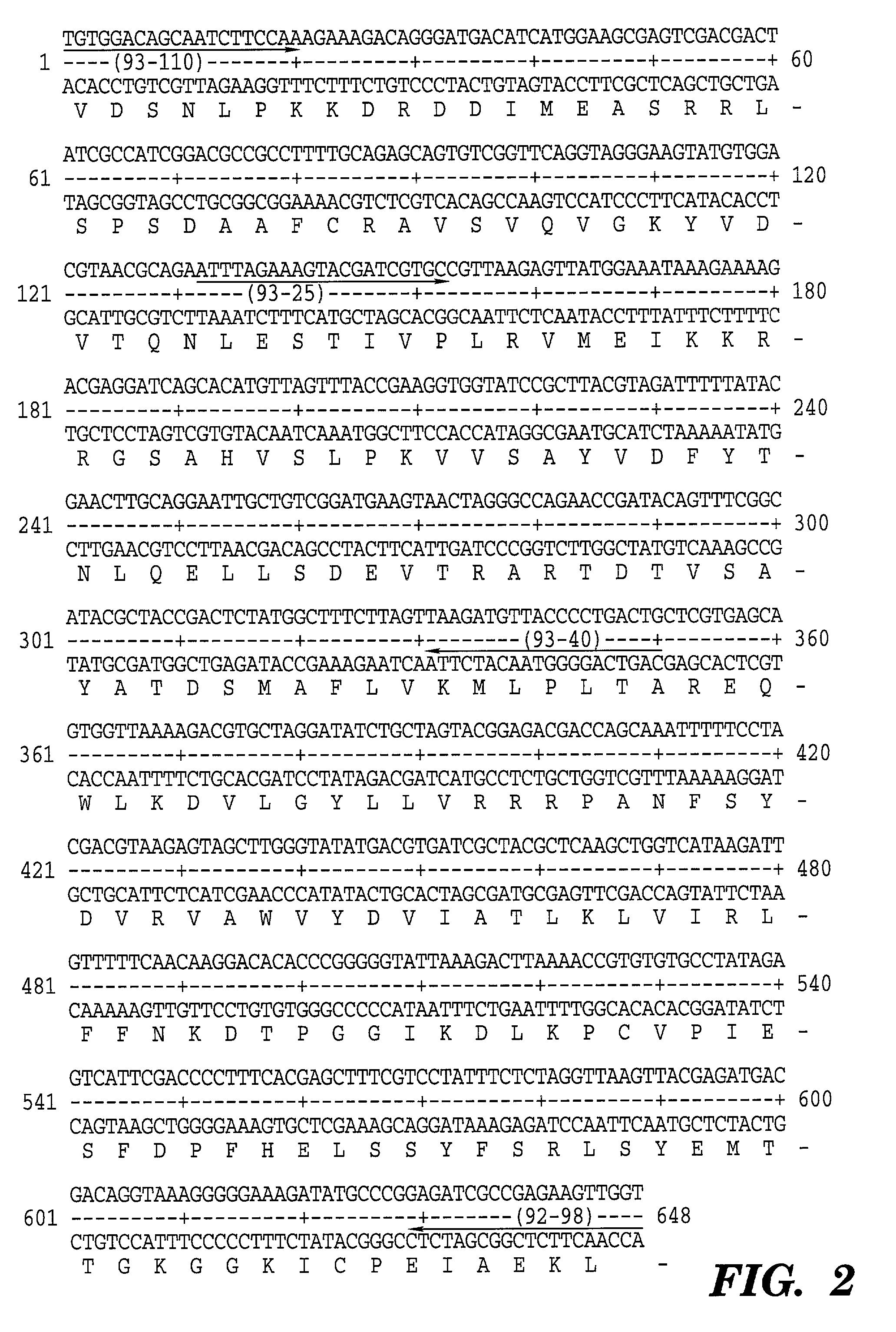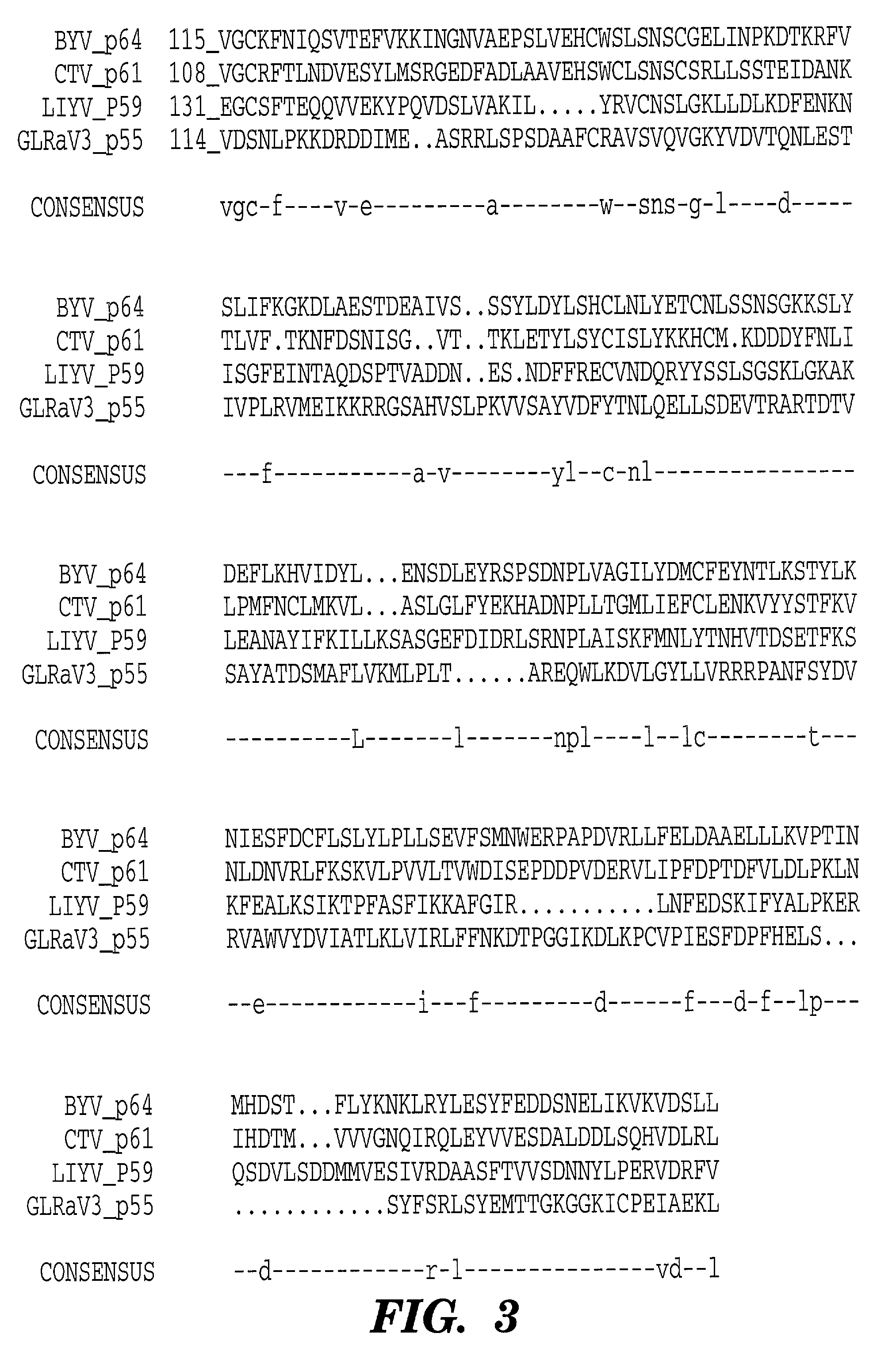Grapevine leafroll virus proteins and their uses
a technology protein, applied in the field of grapevine leaf roll virus protein, can solve the problems of difficult traditional breeding for disease resistance, substantial loss of production, and inability to introduce a new cultivar
- Summary
- Abstract
- Description
- Claims
- Application Information
AI Technical Summary
Benefits of technology
Problems solved by technology
Method used
Image
Examples
example 1
[0124] Materials and Methods
[0125] Virus purification and dsRNA isolation. The NY1 isolate, which is also referred to as isolate GLRaV 109 by Golino, "The Davis Grapevine Virus Collection," Amer. J. Enol. Vitic, 43:200-205 (1992), a member of GLRaV-3 (Hu et al., "Characterization of Closterovirus-like Particles Associated with Grapevine Leafroll Disease," J. Phytopathol. (Berl.), 128:1-14 (1990) ("Hu (1990)") and Zee et al., "Cytopathology of Leafroll-Diseased Grapevines and the Purification and Serology of Associated Closteroviruslike Particles," Phytopathology, 77:1427-1434 (1987) ("Zee (1987)"), which are hereby incorporated by reference) was used throughout this work. Leafroll-diseased canes and mature leaves were collected from a vineyard in central New York State, and kept at -20.degree. C. until used. GLRaV-3 virus particles were purified according to the method described by Zee (1987), which is hereby incorporated by reference, and modified later by Hu (1990), which is incor...
example 2
[0147] Virus Purification and dsRNA Isolation.
[0148] GLRaV-3 virus particles were purified directly from field collected samples of infected grapevines. Attempts to use genomic RNA for cDNA cloning failed due to low yield of virus particles with only partial purity (FIG. 1). However, under an electron microscope, virus particles were shown to be decorated by GLRaV-3 antibody. The estimated coat protein molecular weight of 41K agreed with an earlier study (Hu (1990), which is hereby incorporated by reference). Because of low yield in virus purification, dsRNA isolation was further pursued. Based on the assumption that high Mr dsRNA (16 kb) is the replicative form of the GLRaV-3 genomic RNA, this high Mr dsRNA was separated from other smaller ones by electrophoresis (FIG. 5), purified from a low melting temperature agarose gel, and used for cDNA synthesis.
example 3
[0149] cDNA Synthesis, Molecular Cloning, and Analysis of cDNA Clones.
[0150] First-strand cDNA was synthesized with AMV reverse transcriptase from purified 16 kb dsRNA which had been denatured with 10 mM MeHg. Only random primers were used to prime the denatured dsRNA because several other closteroviruses (BYV, CTV, and LIYV) have been shown to have no polyadenylated tail on the 3' end (Agranovsky et al., "Nucleotide Sequence of the 3'-Terminal Half of Beet Yellows Closterovirus RNA Genome Unique Arrangement of Eight Virus Genes," Journal of General Virolocy, 72:15-24 (1991) ("Agranovsky (1991)"), Agranovsky et al., "Beet Yellows Closterovirus: Complete Genome Structure and Identification of a Papain-like Thiol Protease," Virology, 198:311-324 (1994) ("Agranovsky (1994)"), Karasev et al., "Complete Sequence of the Citrus Tristeza Virus RNA Genome," Virology, 208:511-520 (1995) ("Karasev (1995)"), Klaassen et al., "Genome Structure and Phylogenetic Analysis of Lettuce Infectious Yell...
PUM
 Login to View More
Login to View More Abstract
Description
Claims
Application Information
 Login to View More
Login to View More - R&D
- Intellectual Property
- Life Sciences
- Materials
- Tech Scout
- Unparalleled Data Quality
- Higher Quality Content
- 60% Fewer Hallucinations
Browse by: Latest US Patents, China's latest patents, Technical Efficacy Thesaurus, Application Domain, Technology Topic, Popular Technical Reports.
© 2025 PatSnap. All rights reserved.Legal|Privacy policy|Modern Slavery Act Transparency Statement|Sitemap|About US| Contact US: help@patsnap.com



